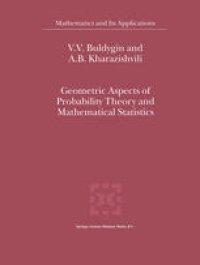
Ebook: Geometric Aspects of Probability Theory and Mathematical Statistics
- Tags: Probability Theory and Stochastic Processes, Statistics general, Convex and Discrete Geometry, Measure and Integration, Functional Analysis
- Series: Mathematics and Its Applications 514
- Year: 2000
- Publisher: Springer Netherlands
- Edition: 1
- Language: English
- pdf
It is well known that contemporary mathematics includes many disci plines. Among them the most important are: set theory, algebra, topology, geometry, functional analysis, probability theory, the theory of differential equations and some others. Furthermore, every mathematical discipline consists of several large sections in which specific problems are investigated and the corresponding technique is developed. For example, in general topology we have the following extensive chap ters: the theory of compact extensions of topological spaces, the theory of continuous mappings, cardinal-valued characteristics of topological spaces, the theory of set-valued (multi-valued) mappings, etc. Modern algebra is featured by the following domains: linear algebra, group theory, the theory of rings, universal algebras, lattice theory, category theory, and so on. Concerning modern probability theory, we can easily see that the clas sification of its domains is much more extensive: measure theory on ab stract spaces, Borel and cylindrical measures in infinite-dimensional vector spaces, classical limit theorems, ergodic theory, general stochastic processes, Markov processes, stochastical equations, mathematical statistics, informa tion theory and many others.
This book demonstrates the usefulness of geometric methods in probability theory and mathematical statistics, and shows close relationships between these disciplines and convex analysis. Deep facts and statements from the theory of convex sets are discussed with their applications to various questions arising in probability theory, mathematical statistics, and the theory of stochastic processes. The book is essentially self-contained, and the presentation of material is thorough in detail.
Audience: The topics considered in the book are accessible to a wide audience of mathematicians, and graduate and postgraduate students, whose interests lie in probability theory and convex geometry.
This book demonstrates the usefulness of geometric methods in probability theory and mathematical statistics, and shows close relationships between these disciplines and convex analysis. Deep facts and statements from the theory of convex sets are discussed with their applications to various questions arising in probability theory, mathematical statistics, and the theory of stochastic processes. The book is essentially self-contained, and the presentation of material is thorough in detail.
Audience: The topics considered in the book are accessible to a wide audience of mathematicians, and graduate and postgraduate students, whose interests lie in probability theory and convex geometry.
Content:
Front Matter....Pages i-x
Convex sets in vector spaces....Pages 1-18
Brunn-Minkowski inequality....Pages 19-36
Convex polyhedra....Pages 37-48
Two classical isoperimetric problems....Pages 49-56
Some infinite-dimensional vector spaces....Pages 57-70
Probability measures and random elements....Pages 71-94
Convergence of random elements....Pages 95-106
The structure of supports of Borel measures....Pages 107-122
Quasi-invariant probability measures....Pages 123-144
Anderson inequality and unimodal distributions....Pages 145-172
Oscillation phenomena and extensions of measures....Pages 173-196
Comparison principles for Gaussian processes....Pages 197-220
Integration of vector-valued functions and optimal estimation of stochastic processes....Pages 221-254
Back Matter....Pages 255-303
This book demonstrates the usefulness of geometric methods in probability theory and mathematical statistics, and shows close relationships between these disciplines and convex analysis. Deep facts and statements from the theory of convex sets are discussed with their applications to various questions arising in probability theory, mathematical statistics, and the theory of stochastic processes. The book is essentially self-contained, and the presentation of material is thorough in detail.
Audience: The topics considered in the book are accessible to a wide audience of mathematicians, and graduate and postgraduate students, whose interests lie in probability theory and convex geometry.
Content:
Front Matter....Pages i-x
Convex sets in vector spaces....Pages 1-18
Brunn-Minkowski inequality....Pages 19-36
Convex polyhedra....Pages 37-48
Two classical isoperimetric problems....Pages 49-56
Some infinite-dimensional vector spaces....Pages 57-70
Probability measures and random elements....Pages 71-94
Convergence of random elements....Pages 95-106
The structure of supports of Borel measures....Pages 107-122
Quasi-invariant probability measures....Pages 123-144
Anderson inequality and unimodal distributions....Pages 145-172
Oscillation phenomena and extensions of measures....Pages 173-196
Comparison principles for Gaussian processes....Pages 197-220
Integration of vector-valued functions and optimal estimation of stochastic processes....Pages 221-254
Back Matter....Pages 255-303
....